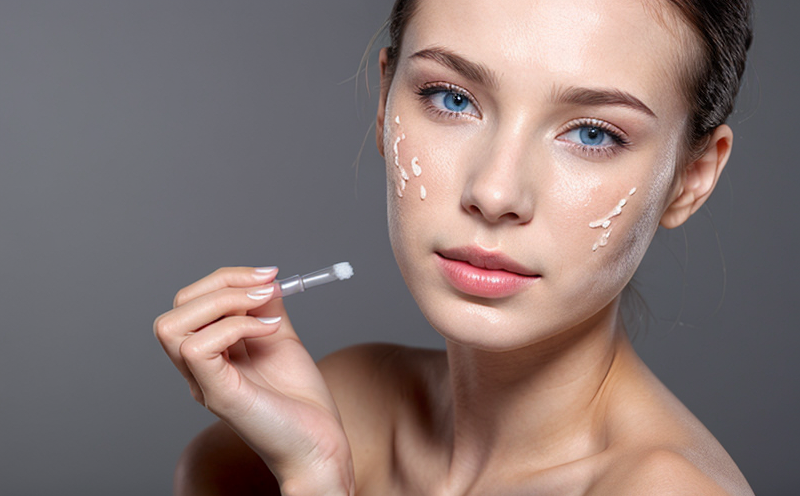Irritation Testing of Cosmetic Gel Formulations
Testing skin irritation and sensitization in cosmetic gel formulations is a critical step towards ensuring product safety and compliance with international standards. The formulation's texture, which is often viscous and thick due to the presence of various gelling agents like hydroxyethylcellulose or xanthan gum, poses unique challenges for testing.
The primary objective in this context is to assess whether a cosmetic gel formulation causes adverse reactions on human skin. This type of evaluation is particularly important given that many consumers are increasingly concerned about the safety and quality of the products they use daily. In Europe, the Cosmetics Regulation (EC) 1272/2008 requires manufacturers to conduct this testing if there's a significant risk or suspicion of sensitization.
The test typically involves applying a sample gel formulation onto the skin of guinea pigs for a specified duration—usually four hours. Following this period, the treated area is examined for signs of irritation and inflammation. If no adverse reactions are observed within a set observation window (typically 14 days), then the product passes the test.
The methodology can also incorporate the use of alternative testing methods such as the Bovine Corneodeepen assay or the Guinea Pig Maximization Test when full animal testing is not feasible. These alternatives adhere to principles outlined in OECD and EU guidelines, ensuring that the approach remains both ethical and scientifically robust.
- International Acceptance: The results of skin irritation tests conducted according to international standards are widely accepted across various countries including those within the European Union (EU), United States (US), Japan, and Australia/New Zealand. Compliance with these guidelines ensures that your cosmetic gel formulations meet global market requirements.
- Market Impact: Passing such rigorous testing enhances a brand's reputation for quality and safety, which can translate into increased consumer trust and higher sales volumes. It also opens doors to international markets where stringent regulations are enforced.
Benefits
The benefits of conducting irritation testing on cosmetic gel formulations extend beyond mere compliance with regulatory requirements; they encompass significant advantages for businesses operating within the cosmetics sector. By ensuring that their products do not cause any form of skin irritation, companies can significantly reduce liability risks associated with potential lawsuits due to adverse reactions.
Additionally, successful completion of these tests provides an opportunity to differentiate one's product offering from competitors who may not adhere strictly to such stringent protocols. This competitive edge translates into enhanced brand loyalty among customers who prioritize health and safety when choosing beauty products.
- Increased Consumer Trust: When consumers know that a company has taken all necessary measures to ensure the safety of its products, they are more likely to purchase from them repeatedly. This builds long-term relationships between brands and their customer base.
- Premium Pricing Potential: Brands that invest in thorough testing can often command premium pricing for their products based on perceived higher quality standards.
International Acceptance and Recognition
The global nature of the cosmetics industry necessitates that manufacturers adhere to internationally recognized testing protocols. Several key bodies oversee and standardize these practices, including the Organization for Economic Co-operation and Development (OECD), European Union (EU) regulations, US Food and Drug Administration (FDA), and International Organization for Standardization (ISO).
For instance, ISO 10993-11 specifies criteria for the dermal irritation test of medical devices, which can be adapted for cosmetic products. Similarly, FDA's animal welfare guidelines encourage alternative testing methods when possible to minimize the use of live animals.
- Key International Standards: ISO 10993-27:2015 outlines requirements and test guidance for dermal irritation testing on medical devices, which can be applied to cosmetics. This standard ensures that all involved parties are working towards common goals regarding product safety.
- Regulatory Compliance: Adherence to these international standards guarantees that your cosmetic gel formulation meets the necessary requirements set forth by regulatory bodies around the world.
Competitive Advantage and Market Impact
In today's competitive marketplace, standing out requires not only innovation in product development but also unwavering commitment to quality assurance. By investing in thorough skin irritation testing, companies demonstrate their dedication to producing safe and reliable cosmetic gel formulations.
Moreover, successful completion of these tests positions brands favorably against competitors who might be cutting corners on safety measures. Such actions foster customer confidence, leading to increased market share and profitability.
- Enhanced Brand Reputation: A reputation for producing safe products can lead to greater brand loyalty among consumers.
- Premium Pricing Power: Brands known for rigorous testing may be able to charge higher prices without compromising sales volumes.





